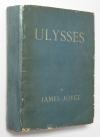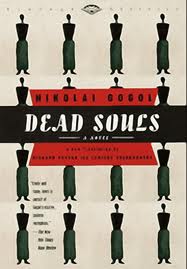Author Photo And Bio
Ten works of fiction that have been great for me.
 1. The Odyssey by Homer (ninth century b.c.e.?). Where The Iliad tells of war, The Odyssey is the story of survival and reconciliation following the ten-year battle with Troy. Where Achilles was defined by warrior brutality, Odysseus, King of Ithaca, is defined by his intelligence and wit. This epic poem follows Odysseus on his adventures as he struggles —against the threats of sea monsters and the temptation of the sirens’ song —to be reunited with his son Telemachus, his faithful, clever queen Penelope, and their kingdom.
1. The Odyssey by Homer (ninth century b.c.e.?). Where The Iliad tells of war, The Odyssey is the story of survival and reconciliation following the ten-year battle with Troy. Where Achilles was defined by warrior brutality, Odysseus, King of Ithaca, is defined by his intelligence and wit. This epic poem follows Odysseus on his adventures as he struggles —against the threats of sea monsters and the temptation of the sirens’ song —to be reunited with his son Telemachus, his faithful, clever queen Penelope, and their kingdom.
 2. The Bible. (See appreciation below).
2. The Bible. (See appreciation below).
 3. King Lear by William Shakespeare (1605). Considered one of Shakespeare’s four “core tragedies”—with Hamlet, Othello, and Macbeth—King Lear commences with Lear, having achieved great age but little wisdom, dividing his kingdom among his three daughters in return for their proclamations of love for him. Two of his daughters, evil to the core, falsely profess their love, while Cordelia, his good and true daughter, refuses his request. Enraged, Lear gives his kingdom to his evil daughters and banishes Cordelia. Lear pays a dear price for this rash act. The play systematically strips him of his kingdom, title, retainers, clothes, and sanity in a process so cruel and unrelenting as to be nearly unendurable.
3. King Lear by William Shakespeare (1605). Considered one of Shakespeare’s four “core tragedies”—with Hamlet, Othello, and Macbeth—King Lear commences with Lear, having achieved great age but little wisdom, dividing his kingdom among his three daughters in return for their proclamations of love for him. Two of his daughters, evil to the core, falsely profess their love, while Cordelia, his good and true daughter, refuses his request. Enraged, Lear gives his kingdom to his evil daughters and banishes Cordelia. Lear pays a dear price for this rash act. The play systematically strips him of his kingdom, title, retainers, clothes, and sanity in a process so cruel and unrelenting as to be nearly unendurable.
 4. The Divine Comedy by Dante Alighieri (1321). Dante’s poetic trilogy traces the journey of a man’s soul from darkness (The Inferno) to the revelation of divine light (Paradiso) while providing commentary and gossip about the politics and prominent families of Florence. Led in his pilgrimage through the underworld and purgatory by the Greek poet, Virgil, Dante is escorted into paradise by his early beloved, Beatrice, while learning that, in order to ascend, he must be transformed.
4. The Divine Comedy by Dante Alighieri (1321). Dante’s poetic trilogy traces the journey of a man’s soul from darkness (The Inferno) to the revelation of divine light (Paradiso) while providing commentary and gossip about the politics and prominent families of Florence. Led in his pilgrimage through the underworld and purgatory by the Greek poet, Virgil, Dante is escorted into paradise by his early beloved, Beatrice, while learning that, in order to ascend, he must be transformed.
 5. Ulysses by James Joyce (1922). Filled with convoluted plotting, scrambled syntax, puns, neologisms, and arcane mythological allusions, Ulysses recounts the misadventures of schlubby Dublin advertising salesman Leopold Bloom on a single day, June 16, 1904. As Everyman Bloom and a host of other characters act out, on a banal and quotidian scale, the major episodes of Homer’s Odyssey —including encounters with modern-day sirens and a Cyclops —Joyce’s bawdy mock-epic suggests the improbability, perhaps even the pointlessness, of heroism in the modern age.
5. Ulysses by James Joyce (1922). Filled with convoluted plotting, scrambled syntax, puns, neologisms, and arcane mythological allusions, Ulysses recounts the misadventures of schlubby Dublin advertising salesman Leopold Bloom on a single day, June 16, 1904. As Everyman Bloom and a host of other characters act out, on a banal and quotidian scale, the major episodes of Homer’s Odyssey —including encounters with modern-day sirens and a Cyclops —Joyce’s bawdy mock-epic suggests the improbability, perhaps even the pointlessness, of heroism in the modern age.
 6. The Hamlet by William Faulkner (1940). The first novel in Faulkner’s Snopes trilogy —which was followed by The Town (1957) and The Mansion (1959)—The Hamlet is a series of linked stories centering on the family’s rise after the Civil War. Clever, ambitious, coarse, and unscrupulous, they embody Faulkner’s ambivalence for the New South, which he saw as a land of greater opportunity and diminished culture. Mixing humor, tragedy, violence, and pathos, The Hamlet is considered Faulkner’s last great novel.
6. The Hamlet by William Faulkner (1940). The first novel in Faulkner’s Snopes trilogy —which was followed by The Town (1957) and The Mansion (1959)—The Hamlet is a series of linked stories centering on the family’s rise after the Civil War. Clever, ambitious, coarse, and unscrupulous, they embody Faulkner’s ambivalence for the New South, which he saw as a land of greater opportunity and diminished culture. Mixing humor, tragedy, violence, and pathos, The Hamlet is considered Faulkner’s last great novel.
 7. Alice’s Adventures in Wonderland by Lewis Carroll (1865). Young Alice follows a worried, hurrying White Rabbit into a topsy-turvy world, where comestibles make you grow and shrink, and flamingoes are used as croquet mallets. There she meets many now-beloved characters, such as the Mad Hatter, the Cheshire Cat, and the Queen of Hearts, in this linguistically playful tale that takes a child’s-eye view of the absurdities of adult manners.
7. Alice’s Adventures in Wonderland by Lewis Carroll (1865). Young Alice follows a worried, hurrying White Rabbit into a topsy-turvy world, where comestibles make you grow and shrink, and flamingoes are used as croquet mallets. There she meets many now-beloved characters, such as the Mad Hatter, the Cheshire Cat, and the Queen of Hearts, in this linguistically playful tale that takes a child’s-eye view of the absurdities of adult manners.
 8. Dead Souls by Nikolai Gogol (1842). Gogol’s self-proclaimed narrative “poem” follows the comical ambitions of Chichikov, who travels around the country buying the “dead souls” of serfs not yet stricken from the tax rolls. A stinging satire of Russian bureaucracy, social rank, and serfdom, Dead Souls also soars as Gogol’s portrait of “all Russia,” racing on “like a brisk, unbeatable troika” before which “other nations and states step aside to make way.”
8. Dead Souls by Nikolai Gogol (1842). Gogol’s self-proclaimed narrative “poem” follows the comical ambitions of Chichikov, who travels around the country buying the “dead souls” of serfs not yet stricken from the tax rolls. A stinging satire of Russian bureaucracy, social rank, and serfdom, Dead Souls also soars as Gogol’s portrait of “all Russia,” racing on “like a brisk, unbeatable troika” before which “other nations and states step aside to make way.”
 9. Stories of Isaac Babel (1894–1940). “Let me finish my work” was Babel’s final plea before he was executed for treason on the orders of Josef Stalin. Though incomplete, his work is enduring. In addition to plays and screenplays, some in collaboration with Sergei Eisenstein, Babel made his mark with The Odessa Stories, which focused on gangsters from his native city, and even more important, the collection entitled Red Cavalry. Chaos, bloodshed, and mordant fatalism dominate those interconnected stories, set amid the Red Army’s Polish campaign during the Russian Civil War. Babel, himself a combat veteran, embodied the war’s extremes in the (doubtless autobiographically based) war correspondent–propagandist Kiril Lyutov and the brutally violent Cossack soldiers whom he both fears and admires. Several masterpieces herein (including “A Letter,” “My First Goose,” and “Berestechko”) anticipate Hemingway’s later achievement, and confirm Babel’s place among the great modernist writers.
9. Stories of Isaac Babel (1894–1940). “Let me finish my work” was Babel’s final plea before he was executed for treason on the orders of Josef Stalin. Though incomplete, his work is enduring. In addition to plays and screenplays, some in collaboration with Sergei Eisenstein, Babel made his mark with The Odessa Stories, which focused on gangsters from his native city, and even more important, the collection entitled Red Cavalry. Chaos, bloodshed, and mordant fatalism dominate those interconnected stories, set amid the Red Army’s Polish campaign during the Russian Civil War. Babel, himself a combat veteran, embodied the war’s extremes in the (doubtless autobiographically based) war correspondent–propagandist Kiril Lyutov and the brutally violent Cossack soldiers whom he both fears and admires. Several masterpieces herein (including “A Letter,” “My First Goose,” and “Berestechko”) anticipate Hemingway’s later achievement, and confirm Babel’s place among the great modernist writers.
 10. A Connecticut Yankee in King Arthur’s Court by Mark Twain (1889). Few writers made ideas as entertaining as Twain, whose gifts are on full display when he transports an ingenious American named Hank “The Boss” Morgan to sixth-century England. The clash of sixth-and nineteenth-century mores allows Twain to offer scorching satires of compulsory religion, aristocracy, and superstition —and smart considerations of subjects ranging from slavery, trade unions, and technology to death and taxes —within the thrilling atmosphere of the Round Table and its legendary characters, including Lancelot, Merlin, and Guenever.
10. A Connecticut Yankee in King Arthur’s Court by Mark Twain (1889). Few writers made ideas as entertaining as Twain, whose gifts are on full display when he transports an ingenious American named Hank “The Boss” Morgan to sixth-century England. The clash of sixth-and nineteenth-century mores allows Twain to offer scorching satires of compulsory religion, aristocracy, and superstition —and smart considerations of subjects ranging from slavery, trade unions, and technology to death and taxes —within the thrilling atmosphere of the Round Table and its legendary characters, including Lancelot, Merlin, and Guenever.
Appreciation of the Bible by Andrew Hudgins
The Bible is both a holy book and a work of supreme fiction; those of us who read it both ways are doubly blessed. One does not need to believe in God to hear the majesty of the story that begins, “In the beginning, God created the heaven and the earth. And the earth was without form, and void; and darkness was upon the face of the deep. And the Spirit of God moved upon the face of the waters. And God said, Let there be light: and there was light.” A great story itself, the Bible is also the source of great stories, by geniuses from Dante to Dostoevsky, Faulkner to Thomas Mann, and the poetry of the Psalms echoes through great poetry from William Blake to Walt Whitman to T. S. Eliot.
One does not have to believe Jesus is the Son of God to understand that his parables are penetrating works of fiction that embody complex truths about human nature. One need not believe Adam and Eve existed to see Genesis is, whatever else it is, a philosophically sophisticated and psychologically acute story about people’s innate response to authority, even loving authority. And it is perfectly possible to believe Moses and King David are fictional, and yet find true to life the Bible’s stories of these flawed men who succeed greatly, if only partially, while failing God time and again.
And what of Jesus—a god entering history as a man and living as a mortal? True or not true, “the greatest story ever told,” in the majesty of its telling and the power of its message, has taught an entire culture how to think about love, suffering, and transcendence, and it has fundamentally colored the language by which we talk about everything.